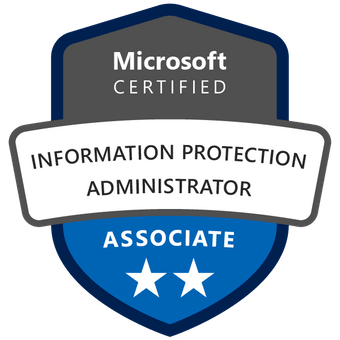
Course Description
Learn how to protect information in your Microsoft 365 deployment. This course focuses on data lifecycle management and information protection and compliance within your organization. The course covers implementation of data loss prevention policies, sensitive information types, sensitivity labels, data retention policies, Microsoft Purview Message Encryption, audit, eDiscovery, and insider risk among other related topics. The course helps learners prepare for the Microsoft Information Protection Administrator exam (SC-400).
Who Should Attend?
The information protection administrator translates an organization’s risk and compliance requirements into technical implementation. They are responsible for implementing and managing solutions for content classification, data loss prevention (DLP), information protection, data lifecycle management, records management, privacy, risk, and compliance. They also work with other roles that are responsible for governance, data, and security to evaluate and develop policies to address an organization's risk reduction and compliance goals. This role assists workload administrators, business application owners, human resources departments, and legal stakeholders to implement technology solutions that support the necessary policies and controls.
About this course
Course Outline
-
Implement information protection (25–30%)
-
Implement DLP (15–20%)
-
Implement data lifecycle and records management (10–15%)
-
Monitor and investigate data and activities by using Microsoft Purview (15–20%)
-
Manage insider and privacy risk in Microsoft 365 (15–20%)
-
Identify sensitive information requirements for an organization's data
-
Translate sensitive information requirements into built-in or custom sensitive info types
-
Create and manage custom sensitive info types
-
Create and manage exact data match (EDM) classifiers
-
Implement document fingerprinting
-
Identify when to use trainable classifiers
-
Design and create a trainable classifier
-
Test a trainable classifier
-
Retrain a trainable classifier
-
Implement roles and permissions for administering sensitivity labels
-
Define and create sensitivity labels
-
Configure and manage sensitivity label policies
-
Configure auto-labeling policies for sensitivity labels
-
Monitor data classification and label usage by using Content explorer, Activity explorer, and audit search
-
Apply bulk classification to on-premises data by using the Microsoft Purview Information Protection scanner
-
Manage protection settings and marking for applied sensitivity labels
-
Design an email encryption solution based on methods available in Microsoft 365
-
Implement Microsoft Purview Message Encryption
-
Implement Microsoft Purview Advanced Message Encryption
-
Design DLP policies based on an organization’s requirements
-
Configure permissions for DLP
-
Create and manage DLP policies
-
Interpret policy and rule precedence in DLP
-
Configure a Microsoft Defender for Cloud Apps file policy to use DLP policies
-
Configure advanced DLP rules for devices in DLP policies
-
Configure Endpoint DLP settings
-
Recommend a deployment method for device onboarding
-
Identify endpoint requirements for device onboarding
-
Monitor endpoint activities
-
Implement the Microsoft Purview Extension
-
Analyze DLP reports
-
Analyze DLP activities by using Activity explorer
-
Remediate DLP alerts in the Microsoft Purview compliance portal
-
Remediate DLP alerts generated by Defender for Cloud Apps
-
Plan for information retention and disposition by using retention labels
-
Create retention labels for data lifecycle management
-
Configure and manage adaptive scopes
-
Configure a retention label policy to publish labels
-
Configure a retention label policy to auto-apply labels
-
Interpret the results of policy precedence, including using Policy lookup
-
Create and apply retention policies for SharePoint Online and OneDrive
-
Create and apply retention policies for Microsoft 365 groups
-
Create and apply retention policies for Teams
-
Create and apply retention policies for Yammer
-
Create and apply retention policies for Exchange Online
-
Apply mailbox holds in Exchange Online
-
Implement Exchange Online archiving policies
-
Configure preservation locks for retention policies and retention label policies
-
Recover retained content in Microsoft 365
-
Create and configure retention labels for records management
-
Manage retention labels by using a file plan, including file plan descriptors
-
Classify records by using retention labels and retention label policies
-
Manage event-based retention
-
Manage the disposition of content in records management
-
Configure records management settings, including retention label settings and disposition settings
-
Plan for regulatory compliance in Microsoft 365
-
Create and manage assessments
-
Create and modify custom templates
-
Interpret and manage improvement actions
-
Create and manage alert policies for assessments
-
Choose between eDiscovery (Standard) and eDiscovery (Premium) based on an organization’s requirements
-
Plan and implement eDiscovery
-
Delegate permissions to use eDiscovery and Content search
-
Perform searches and respond to results from eDiscovery
-
Manage eDiscovery cases
-
Perform searches by using Content search
-
Choose between Audit (Standard) and Audit (Premium) based on an organization’s requirements
-
Plan for and configure auditing
-
Investigate activities by using the unified audit log
-
Review and interpret compliance reports and dashboards
-
Configure alert policies
-
Configure audit retention policies
-
Plan for communication compliance
-
Create and manage communication compliance policies
-
Investigate and remediate communication compliance alerts and reports
-
Plan for insider risk management
-
Create and manage insider risk management policies
-
Investigate and remediate insider risk activities, alerts, and reports
-
Manage insider risk cases
-
Manage forensic evidence settings
-
Manage notice templates
-
Plan for IBs
-
Create and manage IB segments and policies
-
Configure Teams, SharePoint Online, and OneDrive to enforce IBs, including setting barrier modes
-
Investigate issues with IB policies
-
Configure and maintain privacy risk management
-
Create and manage Privacy Risk Management policies
-
Identify and monitor potential risks involving personal data
-
Evaluate and remediate alerts and issues
-
Implement and manage subject rights requests
Prerequisites
Successful Azure Administrators start this role with experience in virtualization, networking, identity, and storage.
-
Understanding of on-premises virtualization technologies, including: VMs, virtual networking, and virtual hard disks.
-
Understanding of network configurations, including TCP/IP, Domain Name System (DNS), virtual private networks (VPNs), firewalls, and encryption technologies.
-
Understanding of Active Directory concepts, including users, groups, and role-based access control.
-
Understanding of resilience and disaster recovery, including backup and restore operations.
Where
This will be a virtual event hosted on Microsoft Teams. In the Microsoft Teams platform and sessions, your name, email address, or title may be viewable by other participants. By joining this event, you agree to this experience.
